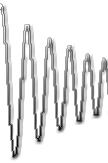First, we introduce the concept of a signal and a system. We immediately notice that there are two fundamentally different kinds of signal: continuous and discrete. The remainder of the course develops parallel theories and equations for each type of signal. Both signals and systems can grouped into classes that those that possess certain properties and those that do not. The properties will be important in helping to establish when relationships apply.
We then shift our focus to systems, and study how to determine the output of a system given its inputs (and sometimes vice versa). A very interesting class of systems may be completely described by the response to canonical inputs, which leads us to the convolution operator. In the context of convolution, we can begin to describe classes of systems as signals. Once we make this connection, we jump to thinking about signals in other representations. Notably, convolution becomes much easier in a frequency representation. We conclude up by discussing how to convert a signal represented in time on one represented in frequency by using Fourier mathematics. Thus, we encounter an extremely powerful a way of thinking about the interactions of signals and systems.
|



